You are getting to grips with converting your mathematics teaching over to Moodle. Suppose you want to include a fragment of mathematics notation in your course. It might be a simple fraction, Many will simply write this as 1/2, using a forward slash between the '1' and the '2'. However, writing fractions in this notation often causes confusion and looks slightly unprofessional. To overcome this, you would rather have a nice horizontal vinculum between the numerator and denominator. The need to write a fraction properly is a simple requirement, and one that's obviously not limited to purely mathematics teaching, or even to a numerate discipline. But what if you need to include a much more complex fragment of mathematics, such as the continuous compounding of interest in economics:

What is the best way to include mathematical notation in a Moodle course? What if you don't want to stop at just mathematical notation? For instance, how do you include graphs of functions? What free tools are available to support teaching different branches of mathematics (for example, geometry) in Moodle? If it isn't obvious, how to include something as trivial as a fraction in a Moodle course, then is it going to be difficult to include something more complicated? You'll find the answers to these questions (and many more) in this book.
We'll start this chapter by exploring the advantages of converting mathematics teaching over to Moodle. Then, I'm going to begin converting my teaching over to Moodle by uploading a past exam paper to my new Moodle course. In order to support my students as they work through the paper and to judge what subject areas we need to go over again before the actual exam, I'm going to provide an online discussion area.
In this chapter we will do the following:
Explore the advantages of converting mathematics teaching over to Moodle
Learn how to upload a past exam paper to your Moodle course
See how easy it is to include an online discussion area in your course
Concepts that are generally hard to visualize (geometry, for example) can be explored interactively (we'll be looking at just a few examples of how this can be achieved in this book). Complex mathematical processes can be explored and investigated at your own pace, and explanations of mathematical processes can be repeated as many times as you need (for example, in a video tutorial). Do you teach blind or visually impaired students? If implemented correctly, moving mathematics teaching online to Moodle can make the notation far more accessible. We'll see how in the later chapters.
Although I assume that you will have an admin at hand to help you set up Moodle to support mathematics, I will certainly be including detailed instructions on how to configure Moodle where that's necessary.
In this book, you'll find detailed instructions on how to configure your Moodle site to support mathematics teaching. Mathematics teachers are a special bunch; it's fair to say that our requirements aren't very well satisfied by an out-of-the-box Moodle install. You'll want to provide the tools that allow your teaching colleagues to create fun, engaging, and innovative online mathematics courses.
In this book, we will be working together to create a Moodle course covering the Pythagorean Theorem. If you aren't teaching mathematics, but want to know how to include mathematics notation in your courses and are put off by not remembering much about Pythagoras, then please don't worry. The key issue is that we work through creating a Moodle course on a topic that will allow us to gain experience using Moodle's most beneficial mathematics tools.
This book is written for Moodle 1.9.x (in fact, I used version 1.9.5 when writing this book). I've tried to include as many screenshots as possible, but don't worry if your Moodle looks slightly different when compared to mine; Moodle can be themed (branded with your organization's logo and colors). In case you're wondering, the theme I'm using is standardwhite. If you do want your Moodle to look like mine, you may need to ask your Moodle admin (if that's not you!) to change the theme for you.
So, let's make a start!
In this book, you'll find detailed instructions on how to configure your Moodle site to support mathematics teaching. Mathematics teachers are a special bunch; it's fair to say that our requirements aren't very well satisfied by an out-of-the-box Moodle install. You'll want to provide the tools that allow your teaching colleagues to create fun, engaging, and innovative online mathematics courses.
In this book, we will be working together to create a Moodle course covering the Pythagorean Theorem. If you aren't teaching mathematics, but want to know how to include mathematics notation in your courses and are put off by not remembering much about Pythagoras, then please don't worry. The key issue is that we work through creating a Moodle course on a topic that will allow us to gain experience using Moodle's most beneficial mathematics tools.
This book is written for Moodle 1.9.x (in fact, I used version 1.9.5 when writing this book). I've tried to include as many screenshots as possible, but don't worry if your Moodle looks slightly different when compared to mine; Moodle can be themed (branded with your organization's logo and colors). In case you're wondering, the theme I'm using is standardwhite. If you do want your Moodle to look like mine, you may need to ask your Moodle admin (if that's not you!) to change the theme for you.
So, let's make a start!
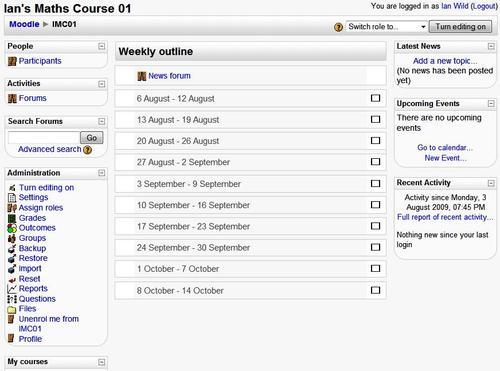
I've got plenty of worksheets, homework handouts, and old exam papers, which I've currently handed out to my students using a shared drive. The big problem I have with our shared drive is that my students always claim that they can never find the work I hand out to them (and if you've seen what a mess the shared drive is at my school, you'd be inclined to believe them).
Let's take a past exam paper and upload that to my Moodle course. First, you'll need to press the Turn editing on button. You'll find this in the top right-hand corner of the page:
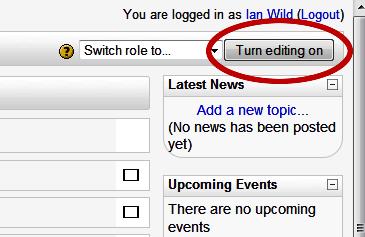
Now, I have the opportunity to add resources and activities to my course and arrange and configure the blocks on the left and right sides of the page:

In each week, there are two drop-down menus. If you haven't already, try exploring these menus now to see what options you have:
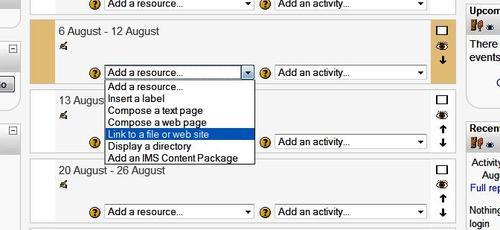
I'm going to choose the first week listed in my course. Click on the Add a resource drop-down menu and select Link to a file or web site:

Now, I'm going to upload a file to my course as follows:
1. Clicking on the Link to a file or web site menu option displays the Adding a new Resource... page:
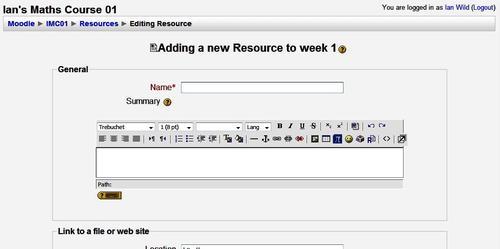
2. Give the link a Name and type a brief description into the Summary box:
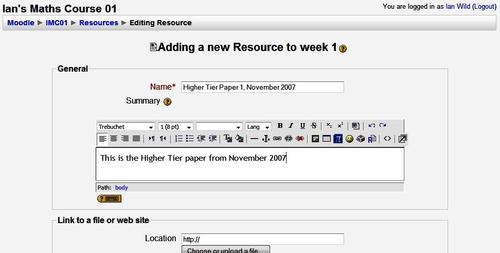
3. I'm going to upload an old exam paper, so I need to scroll down to the Link to a file or web site box and press the Choose or upload a file button:

4. Each course has its own file area—a bit like My Documents in Windows. A new window is displayed showing the contents of the files area for this course, which is empty at the moment:
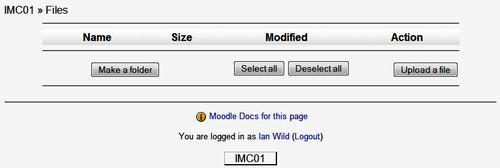
5. I need to upload the exam paper to the course files area, and to do that I first need to click on the Upload a file button under the Action heading:
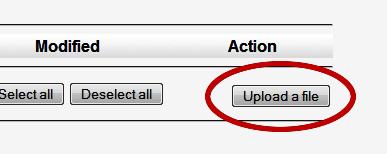
6. I'm now given the opportunity to choose a file on my computer (or from a drive on the network). Select the file you wish to upload, and click on the Upload this file button:
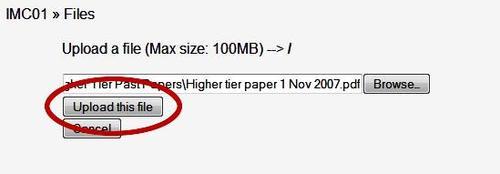
7. Now that the file is uploaded, you'll see it listed in the course files area. To select the file, you need to click on Choose:
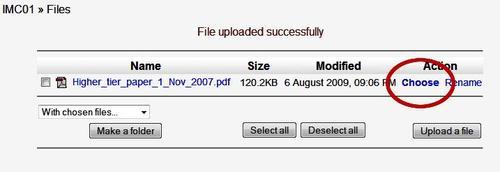
8. The name of the file will now be specified in the Link to a file or web site box:

9. You now need to configure how the file is going to be displayed. I've had problems in the past with students clicking on a file in Moodle, which the browser then opens in the browser itself, making Moodle disappear. For now, I'm going to scroll down to the Window box and select New window from the Window drop-down menu (I'll speak more about how files can be displayed later in this section):
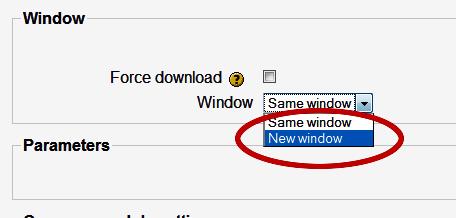
10. Scroll down to the bottom of the page and press the Save and return to course button:

11. I now have a link to the exam paper on my course's front page:

And that's all, there is to it! Try clicking on the link to make sure that the file is displayed correctly.
Before moving on, here are some hints and tips regarding file upload:
Want to upload a lot of files all in one go? Use a compression utility and upload the ZIP file. Alternatively, in Windows, select your files and right-click on them. Slide down to the Send To option and choose Compressed (zipped) Folder. Moodle contains a built-in decompression utility. It will also remember folder structures, if you have folders within folders.
Want to change the way a file is displayed? Rather than having the file opened in a new window, I can choose to display a navigation bar across the top of the page. I can choose that setting on the Adding a new Resource page. To reveal the setting, you will have to press the Show Advanced button in the Window box. Set Window to Same window and Keep navigation visible on the same page to Yes, without frame:
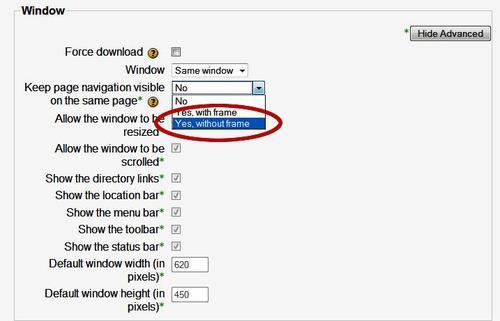
Here's how that old exam paper is now displayed:
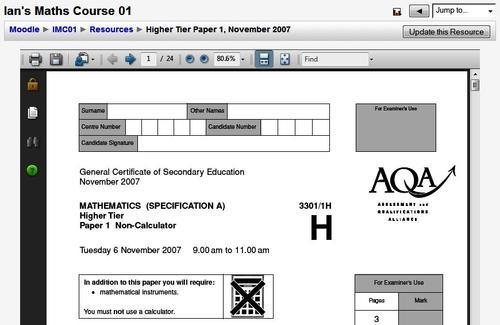
You can upload any digital file to Moodle. But remember, your students will need to have the correct software installed on their computers to view the file. If in doubt, speak to your System Administrator.
Now, I've uploaded an old exam paper to a place where students can discuss problems they are having. This will not only allow me to monitor the topics my students are having problems with, but this will also be a place where students can help each other, encouraging collaborative learning.
What we need now is a Moodle Forum. Let's learn how you can add a forum to your course:
1. Return to your course's front page, and with editing turned on, click on the Add an activity drop-down menu. Choose Forum:

2. Give the forum a name and type in an introduction:

3. For a simple online discussion forum, the default settings will be fine. Scroll down to the bottom of the page and press the Save and return to course button:

4. That's it! I'm done. I've uploaded a past paper and have a place where students can discuss questions they have about the paper:

Obviously, there are a lot of settings in there that I skipped, but hopefully you can see how easy it is to create a simple discussion forum. Click on the link to the forum and experiment with making a post (don't worry, you can delete any test posts you make).
Rather than spending time discussing forums in detail, let me direct you to Moodle Course Conversion: Beginner's Guide. In that book, you'll find more information on forums, including forum moderation strategies.
I've uploaded a past paper in my Moodle course, and I've included a forum to allow us to discuss issues arising from that past paper online. How about exploring a couple of more important course configuration options? Again, I'm not going to go into too much detail regarding reconfiguring a course, but I will quickly direct you to three important settings.
1. Return to your course's front page and look for the Settings option in the course Administration block:

2. On the Edit course settings page, we can change the course name, and we can also change the short name. However, before you do, it might be worth checking with your Moodle Administrator, in case the students are being automatically enrolled in your course:

3. Summarize your course in the Summary box. The course summary is displayed whenever the course is listed:

4. If you want to change your course format from displaying weeks to topics, then you need to click on the Format drop-down menu:

5. To change the number of weeks or topics in your course, click on the Number of weeks/topics drop-down menu.
6. When you are happy with the new settings, scroll down to the bottom of the page and press the Save changes button. Your course will be reconfigured accordingly:

To recap, I have uploaded a past paper to my Moodle course and have included an online discussion forum that allows students to discuss problems online between themselves and me.
One of the questions my students seemed to get stuck on involved a ladder pitched against a vertical wall. You are given the ladder's length and the distance between the bottom of the wall and the foot of the ladder. The question asks you for the height of the top of the ladder from the ground. It's a Pythagorean Theorem question, and my idea is to create a Moodle course specifically covering the Pythagorean Theorem. My Moodle admin has created the course and I've been given the teacher role. In the rest of this book, we'll be working together to create this course.
Our journey with Moodle Mathematics has just begun, yet we've already learned a lot about how we can use Moodle to support our mathematics teaching.
Specifically, we've covered the following:
The advantages of converting mathematics teaching over to Moodle, both from a teacher and student point of view.
How to upload a past paper to a Moodle course. Keep in mind that I could have uploaded any digital file to my course. I just have to make sure my students have the software to open the file on their computers.
How to create an online discussion area.
Basic course configuration settings.
One of the issues we had when my students and I were making forum posts was that we struggled to include even basic mathematics notation. In fact, we hit the very problem with mathematical notation that I described right at the start of this chapter. Let's spend the next chapter solving the problem.




















